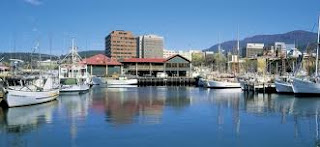Part of the adventure of traveling is the guesswork involved. Where to go? Where to stay? How to meet people? Such questions haunt most travelers, and lead many (though seldom Jan and me!) onto “the road more traveled.” It’s gratifying when, occasionally, our best-made hunches actually pan out!
 |
Jan and I knew we wanted, and needed, to be in Australia for a period of about six weeks. We decided to spend the majority of this time in Hobart, Tasmania—largely because of Quaker connections we hoped to find there. We are not disappointed, either in Hobart (which is an absolute gem of a small city—one of Lonely Planet's "Top Ten Cities"!), or in the connections we’ve made through the Friends’ School (yes, THEY have an apostrophe) and the Friends Meeting on its campus.
 |
I have attended Meeting the past two Sundays, looking out on lofty Mt. Wellington (named for the original “Iron Duke” and dominating the Hobart landscape), hearing familiar messages of peace, justice and love delivered with a new inflection, and making friends with new Friends over tea.
For three weeks, we’ve lived just a five-minute walk from the Friends’ School (founded in 1887 and today serving more than 1300 students, making it the largest Quaker school in the world, I believe). The new Principal is Nelson File, a Philadelphia-area Quaker who formerly taught at Friends Central but spent most of his career (prior to coming to Hobart in January) at international schools in Delhi and the Middle East.
 |
Nelson welcomed me and gave me at two-hour tour of the campus—actually two campuses that are connected by a footbridge. One reason this school is so large is that some of its students are only six months old! The Friends’ School has an extensive “Early Years” program that runs from 7:30 AM to 6:00 PM, five days a week. They also have boarding facilities and a fitness center, open to the public seven days a week, whose slogan is “Be who YOU want to be.” The school motto is “Nemo Sibi Nascitur.” (Mike, isn’t this “Nobody is born for himself”?) Like CFS they have no entrance exams, and teachers work hard to provide many different ways for students of all ages, interests and abilities to be successful, creative, and kind.
 |
Also like CFS, students and teachers here are on a first-name basis. Students at the Quaker school in Hobart seem very comfortable in their skins—even as they wear straw hats (to protect them from the sun here in the skin cancer capital of the world) and a variety of uniforms (many of the blazers sporting piping as playful as the kids are). A Grade 5 class of students that Nelson and I visited were deciding (using the Mac that each student is issued) what worthy cause to donate class money to. This is exactly the activity I remember doing with Christel’s advisee group when I subbed for her not long ago!
 |
The teachers I’ve met at Friends’ School Hobart seem exceptionally friendly and down-to-earth (as most Aussies are), and they have an easy sense of humor in the staff room. Quite a number have been here for decades—another similarity between our school communities. Today I met with Tammy Giblin, head of the arts faculty. She has been at Friends’ for 20 years, and I could readily tell that she is a gifted, dedicated, and well-loved teacher. She and her performing arts colleagues are getting ready to put up the big musical they do every two years with older students. This year it will be the Elton John Aida. They do it in downtown Hobart, at the Theatre Royal, Australia’s oldest theater in continuous operation.
 |
Jan and I loved seeing The Phantom of the Opera there last night. This 1840s theater is a miniature Paris Opera House, and we saw an excellent, full-blown, all-Tasmanian, professional production—with the Friends’ School’s own music teacher beautifully conducting the 30+-piece orchestra.
I talked with Tammy about shows that both our schools have recently
done, including Footloose, Bye Bye Birdie, and The Wizard of Oz. She told me about the IB students she works with
most closely, in addition to the talented teens who join the cast because they
love drama as much as they do science or Australian Rules football, and the
dedicated kids who have been in four Theatre Royal productions during their
years at Friends’! Clearly, teachers at both our schools take similar delight
in nurturing students’ growth in ways that suit individual needs and character.
I gave Tammy and Nelson information about Ariel’s Way, to consider at an appropriate time with their colleagues and students. Both seemed appreciative of what the show is about and of the groundwork that CFS productions put in place. Wouldn’t it be wonderful if this play could build a bridge between—or, at least, add an apostrophe to—two school communities who may exist a world apart but whose ways have opened and evolved, over time, such that they occupy similar niches? Like deer and ‘roos, groundhogs and wombats, Friends and Friends’ have survived and thrived in the separate, but related, world each school inhabits.





















